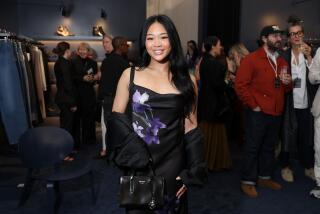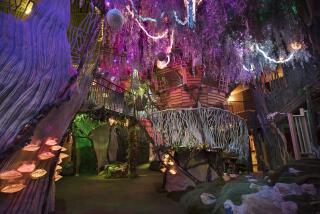Not-so ‘Kindred Spirits’
IT ISN’T THAT when Wal-Mart heiress Alice Walton purchased Asher B. Durand’s 1849 painting “Kindred Spirits” last year she got the state of Arkansas to pass legislation specifically to save her taxes -- in this case, about $3 million on a purchase of $35 million. It isn’t that Walton -- the world’s richest woman and thirteenth-richest person (with a net worth of $18 billion, according to Forbes magazine) -- scooped the painting out from under the National Gallery and the Metropolitan Museum of Art, which had banded together to try to keep it in a public collection when the New York Public Library decided to sell it off.
It isn’t that Walton will eventually stick this talisman of New York cultural life and a lot of other old American paintings in the Crystal Bridges Museum of American Art, the Walton family museum she’s building in Bentonville, Ark., the site of Wal-Mart’s corporate headquarters. After all, people in the middle of the country should get to see some good art too. It might not even be, as WalMartWatch.com points out, that the average Wal-Mart cashier makes $7.92 an hour and, because Wal-Mart likes to keep people on less than full-time schedules, works only 29 hours a week for an annual income of $11,948 -- so a Wal-Mart cashier would have to work a little under 3,000 years to earn the price of the painting.
The trouble lies in what the painting means and what Walton and her $18 billion mean. Art patronage has always been a kind of money-laundering, a pretty public face for fortunes made in uglier ways. The superb Rockefeller folk art collections in several American museums don’t include paintings of the 1914 Ludlow Massacre of miners in Colorado, carried out by Rockefeller goons, and the J. Paul Getty Museum in L.A. doesn’t say a thing about oil. But something about Wal-Mart and “Kindred Spirits” is worse, perhaps because, more than many works of art, Durand’s painting is a touchstone for a set of American ideals that Wal-Mart has been savaging.
“Kindred Spirits” portrays Durand’s friend, the great landscape painter Thomas Cole, with his friend, the poet and editor William Cullen Bryant. The two stand on a projecting rock above a cataract in the Catskills, bathed like all the trees and air around them in golden light. The painting is about friendship freely given, including a sense of friendship, even passion, for the American landscape itself. In the work of Cole, Durand and Bryant, as in the writing of Henry David Thoreau and Walt Whitman, you can see an emerging belief that the love of nature, beauty, truth and freedom are naturally allied, a romantic vision that still lingers as one of the most idealistic versions of what it means to be an American.
Cole was almost the first American painter to see the possibilities in American landscapes, to see that meaning could grow in a place not yet full of ruins and historical associations, and so he became an advocate for wilderness nearly half a century before California’s John Muir took up the calling.
Bryant had gained a reputation as a poet before he became editor-in-chief of the New York Evening Post. He defended striking tailors in 1836, long before there was a union movement, and was ever after a champion of freedom and human rights, turning his newspaper into an antislavery mouthpiece. He was an early supporter of Abraham Lincoln and of the projects that resulted in New York’s Central Park and the Metropolitan Museum -- of a democratic urban culture that believed in the uplifting power of nature and of free access.
“Kindred Spirits” was commissioned by the wealthy dry-goods merchant Jonathan Sturges as a gift for Bryant in commemoration of his beautiful eulogy for Cole, who died suddenly in 1848. Bryant left it to his daughter, Julia, who gave it in 1904 to what became the New York Public Library. It was never a commodity exchanged between strangers until the library, claiming financial need, put it up for sale last year. So now a portrait of antislavery and wilderness advocates belongs to a woman whose profits came from degrading working conditions and ravaging the North American landscape.
MAYBE THE problem is that the Crystal Bridges museum seems like a false front for Wal-Mart, a made-in-America handicrafted artifact of idealism for a corporation that is none of the above. The museum will, as such institutions do, attempt to associate the Wal-Mart billionairess with high culture, American history, beautifully crafted objects -- a host of ideals and pleasures a long way from what you find inside the blank, slabby box of a Wal-Mart. One of the privileges of wealth is buying yourself out of the situation you help to make, so that the wealthy who advocate for environmental deregulation, for instance, then install water purifiers or stock up on cases of Perrier, and those who advocate for small government hire their own security forces and send their children to private schools.
I have always believed that museums love artists the way taxidermists love deer. Perhaps Walton is, in some sense, stuffing and mounting what is best about American culture -- best and fading. Certainly she seems more interested in archaic images of America than in the artistry behind them.
Walton has already scooped up a portrait of George Washington by Charles Willson Peale and paintings by Winslow Homer and Edward Hopper for her museum. She will feature many, many 19th century portraits of Native Americans, reports say, but it would be hard to see her as a champion of the indigenous history of the Americas. The Wal-Mart that opened in November 2004 in Teotihuacan, near Mexico City, is built so close to the Aztec’s Pyramid of the Sun that many consider the site desecrated. The Wal-Mart parking lot eradicated the site of a smaller temple.
Imagine if Walton were more like Sturges, supporting the art of her time. Imagine if she were supporting artists who actually had something to say about Wal-Mart and America (and Mexico, and China). Imagine if, in the mode of the Venice Biennale or the Sao Paulo Biennale, there was a Wal-Mart biennale. After all, Wal-Mart is China’s seventh-largest trading partner, ahead of Germany and Russia and Italy; if it were a nation, it would be the world’s 19th biggest economy. If it’s on the same scale as those countries, why shouldn’t it have its own contemporary art shows? But what would the Wal-Mart nation and its artists look like?
Rather than the open, luminous, intelligent design that architect Moshe Safdie will probably bestow on Bentonville, imagine a shuttered Wal-Mart big box (of which there are so many, often shut down simply to stop employees from unionizing) turned into a MOCA, a museum of contemporary art, or better yet a MOCWA, a Museum of Contemporary Wal-Mart Art. Or Wal-Art. After all, L.A.’s MOCA was originally sited in a defunct warehouse. You could have artists making art entirely out of materials available at Wal-Mart, or to make art about the global politics of Wal-Mart -- poverty, consumerism, sprawl, racism, gender discrimination, the exploitation of undocumented workers.
Imagine a contemporary artist, maybe with Adobe Photoshop, reworking “Kindred Spirits” again and again. Imagine that Cole and Bryant are, this time, standing not on a rocky outcropping but in, say, one of the puzzle and art-supply aisles of a Wal-Mart somewhere in the Catskills, dazed and depressed. Or imagine instead that it’s some sweatshop workers, a little hunched and hungry, on that magnificent perch amid the foliage and the golden light. Imagine paintings of Edward Hopper’s old downtowns, boarded up because all the sad and lonely people are shopping at Wal-Mart and even having their coffee and hot dogs there. Imagine video-portraits of the people who actually make the stuff you can buy at Wal-Mart, or of the African American truck drivers suing the corporation for racism.
Imagine if Wal-Mart acknowledged what Wal-Mart is rather than turning hallowed American art into a fig leaf to paste over naked greed and raw exploitation. But really, it’s up to the rest of us to make the Museum of Wal-Mart, one way or another, in our heads, on our websites, or in our reading of everyday life everywhere.
More to Read
Inside the business of entertainment
The Wide Shot brings you news, analysis and insights on everything from streaming wars to production — and what it all means for the future.
You may occasionally receive promotional content from the Los Angeles Times.









